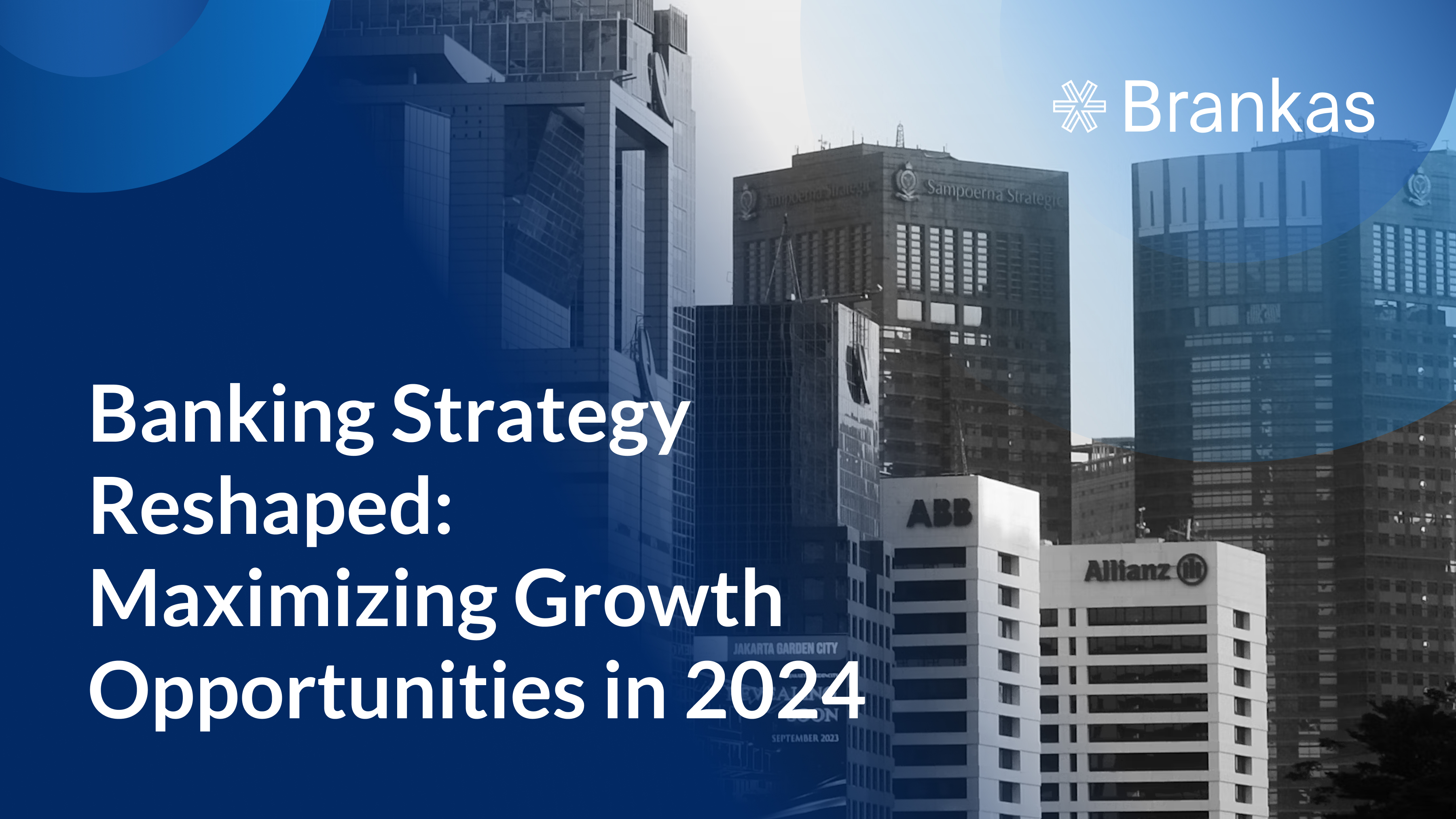
Understanding the intricacies of chargebacks and refunds is paramount for merchants. Chargebacks and refunds play crucial roles in customer satisfaction and maintaining a positive business image.

The world of banking stands on the cusp of transformational change. The financial landscape, once characterized by tradition and stability, has now become a dynamic arena where digitalization, shifting customer expectations, and disruptive forces propel the industry forward. In an era of unprecedented innovation, banking institutions are rewriting their strategies to maximize growth opportunities in 2024.
The importance of an adaptive banking strategy cannot be overstated. What was effective yesterday may not suffice tomorrow as technology, regulation, and market dynamics evolve. The banking sector must reevaluate its very core to remain agile, competitive, and customer-focused. Strategies need to be as fluid as the data-driven decision-making that now powers the financial world.
Financial institutions are now standing on the threshold of substantial opportunity. There are numerous pathways to achieve remarkable and exponential growth despite the challenges. Technology, customer-centricity, sustainability, and ethics are becoming pivotal factors. Finance companies will gain a comprehensive understanding of the challenges and opportunities that lie ahead and how they can successfully adapt and strategize in this dynamic environment.
The banking industry today is characterized by heightened competition, rapidly evolving customer expectations, and an influx of innovative technologies. Traditional banking models, long reliant on brick-and-mortar branches and manual processes, are now confronted with the imperative to transform. While the industry continues to serve as the backbone of the global economy, it is no longer business as usual. Regulatory changes and societal shifts, accelerated by the pandemic, have further accentuated the need for banking institutions to adapt swiftly.
Several key trends and challenges are reshaping the banking sector. First, digitalization is no longer optional; it is a necessity. Consumers now expect seamless online and mobile banking experiences. Simultaneously, emerging technologies like artificial intelligence, blockchain, and open banking are revolutionizing how banks operate. The digital evolution also brings forth concerns about data privacy and security requiring financial institutions to strike a delicate balance. Moreover, the industry faces a global challenge of addressing issues of financial inclusion and sustainability as the world grows more interconnected.
A comprehensive plan involves several vital elements, each contributing to the overall success of financial institutions:
A. Setting clear goals and objectives
Defining specific, measurable, achievable, relevant, and time-bound (SMART) goals is the cornerstone of any effective banking strategy. Banks must meticulously outline their objectives, whether it is enhancing market share, expanding their product portfolio, or fortifying customer relationships. Clear objectives provide a roadmap for all subsequent strategies and ensure that every action aligns with overarching goals. Banks should also continuously monitor progress, allowing for agile adjustments as market dynamics change.
B. Segmenting and targeting the right markets
Banks need to categorize their customer base based on factors like demographics, behavior, and needs. With these segmented groups in mind, banks can tailor their products and services to cater to the unique requirements of each category. Effective segmentation facilitates targeted marketing, personalized customer experiences, and increased customer retention rates. By focusing on the right markets, banks can optimize their marketing efforts and allocate resources where they are most impactful.
C. Leveraging data and analytics
Data is the currency of growth today. Banks must harness the enormous volume of data they collect to gain deep insights into customer behavior, preferences, and market trends. Advanced analytics and artificial intelligence tools can transform this data into actionable intelligence. By using predictive analytics, banks can foresee customer needs, identify growth opportunities, and mitigate risks effectively.
D. Innovation as a driver of strategy
Innovation is the engine of banking growth in 2024. Banks can enhance customer experiences, streamline operations, and introduce novel financial products and services by embracing innovative technologies. This innovation-driven strategy positions banks to meet evolving customer expectations and respond proactively to changes in the market. Collaborations with fintech startups and leveraging the power of emerging technologies, such as blockchain, artificial intelligence, and open banking, offer banks the potential to remain at the forefront of the industry.
Financial institutions can steer through the complex and dynamic landscape of modern banking by weaving these fundamental elements into their banking strategy for 2024. With clear goals, well-defined market segments, data-driven insights, and an innovative mindset, banks are poised to maximize growth opportunities and ensure their enduring relevance in a rapidly changing world.
Finance companies must proactively address challenges to thrive in this new era of banking. These insights cover a range of key challenges and provide tangible strategies to ensure growth and success while fulfilling the evolving needs of customers and the broader financial ecosystem.
A. Technological advancements and their impact
Cutting-edge technologies like artificial intelligence, machine learning, and blockchain continue to reshape the industry. AI-driven algorithms are optimizing customer service, automating financial advice, and enhancing fraud detection. Blockchain is altering the way banks handle payments and verify customer identities. Mobile banking apps and digital wallets are commonplace, providing customers with convenient, on-the-go access to their accounts.
Challenge: Banks must continuously adapt to technological advancements to stay competitive and relevant in a rapidly evolving digital landscape.
Recommendations:
1. Invest in digital transformation.
Prioritize the digitization of your banking services and operations. Develop or acquire user-friendly mobile apps, implement AI-driven chatbots for customer support, and explore blockchain technology for secure and transparent transactions.
2. Cybersecurity is non-negotiable.
With increased technological integration comes higher cyber risks. Invest in robust cybersecurity measures to protect your institution and customer data. Update your cybersecurity protocols regularly and conduct thorough audits to ensure compliance.
3. Stay informed.
Continuously monitor tech trends to identify opportunities that can give your bank a competitive edge. Implement emerging technologies like machine learning for credit risk assessment or blockchain for efficient cross-border transactions.
B. Regulatory changes and compliance challenges
The banking sector’s regulatory environment remains intricate. Banking institutions face an array of evolving regulations that encompass data privacy, cybersecurity, and financial crime prevention. Compliance challenges are compounded by the rise of global, cross-border transactions and the need for standardized reporting.
Challenge: The ever-evolving regulatory landscape demands strict compliance and poses a considerable challenge for banks.
Recommendations:
1. Compliance training
Conduct regular training sessions for your staff to keep them informed about changing regulations. Develop a culture of compliance and emphasize the importance of adhering to laws and regulations.
2. Leverage regulatory technology.
Reg Tech solutions can greatly assist in ensuring compliance. Invest in compliance management systems and tools that offer real-time monitoring, and reporting, and help automate compliance processes.
3. Collaborate with regulators.
Maintain open communication with regulatory authorities. Engage in regular discussions to stay informed about upcoming changes. Collaborative relationships can provide insights into the regulatory environment and help in proactively addressing challenges.
C. Customer expectations in the digital age
2024 places tremendous power in the hands of customers. With the convenience of mobile banking, they can easily switch between providers to find the services that best meet their needs. Today’s customers seek personalized, data-driven recommendations. They want immediate, around-the-clock access to their accounts and transactions.
Challenge: Modern customers expect convenience, personalization, and real-time services in the digital age, challenging banks to meet these demands.
Recommendations:
1. Seamless omnichannel experience
Ensure customers can access your services via various channels, seamlessly transitioning from web to mobile or in-branch. Consistency in service and personalization across these channels is key.
2. Data-driven personalization
Leverage data analytics to understand your customers better and offer personalized services. Use AI to analyze customer behaviors and preferences and tailor your offerings accordingly.
3. Real-time transactions
Invest in systems that enable real-time transactions, including fund transfers, loan approvals, and credit scoring. Speed and efficiency in service delivery will boost customer satisfaction.
D. The rise of sustainable and ethical banking
The call for sustainable and ethical banking practices will grow louder in 2024. Customers are becoming more conscious of the social and environmental impact of their financial choices. They expect banks to invest in green and socially responsible initiatives, and they favor institutions that demonstrate a commitment to ethical financial practices. As a result, sustainable banking practices are no longer an optional bonus but a fundamental component of a bank’s strategy.
Challenge: Customers increasingly expect banks to uphold sustainability and ethical principles in their operations and investments.
Recommendations:
1. Implement ESG principles.
Integrate Environmental, Social, and Governance (ESG) criteria into your banking strategy. Offer financial products that support sustainable practices and ethical investments.
2. Community engagement
Engage in philanthropic and community-based initiatives to exhibit your commitment to ethical banking. This can include supporting local charities or participating in green initiatives.
3. Transparency and reporting
Maintain transparency in your banking practices. Regularly report your adherence to ethical principles and sustainability goals, and publish annual ESG reports for stakeholders.
4. Green financing
Explore green financing options, such as green bonds or sustainable loan products. Partner with organizations committed to green energy and eco-friendly practices to provide customers with sustainable financial solutions.
The actionable insights detailed above are integral components of a strategic approach to leverage the following growth opportunities. Financial institutions can confidently establish themselves as thriving entities in the financial landscape by aligning these insights with the prospective avenues for expansion. This alignment helps secure their market share and allows them to consistently deliver valuable services to a wider and more diverse customer base.
1. Digital lending and credit innovation
The digital era has revolutionized lending. Banks can expand their portfolio by embracing digital lending solutions, such as peer-to-peer lending, online personal loans, and small business loans. This approach enables banks to reach a broader market, cater to tech-savvy borrowers, and expedite loan approval processes, all while maintaining risk management practices.
2. Expansion into emerging markets
As developed markets reach saturation, emerging markets present compelling growth prospects. In regions like Asia, Latin America, and Africa, banks can tap into the unbanked and underbanked populations by providing accessible, low-cost financial services. By extending their reach to these untapped markets, banks can build a loyal customer base that will grow with the increasing financial literacy in these regions.
3. Sustainable banking
The growing trend of sustainable and ethical banking offers significant growth potential. Banks can align their services with environmental, social, and governance (ESG) principles to attract ethically conscious consumers. Sustainable investments, green loans, and green bonds present lucrative opportunities for banks to contribute positively to the planet while expanding their business.
4. Advanced analytics and personalization
Customer data will be a goldmine for banks in 2024. With advanced analytics and artificial intelligence, banks can create personalized financial products and services. By understanding individual customer needs and preferences, banks can offer tailor-made solutions, strengthening customer loyalty and generating additional revenue through cross-selling.
5. Mortgage and real estate finance
The housing market continues to be a focal point for financial growth. Banks can explore opportunities in mortgage lending, property financing, and real estate investment services. These sectors provide steady sources of revenue in regions experiencing real estate booms.
6. Wealth management and retirement planning
The aging population in many parts of the world presents an opening for banks to offer comprehensive wealth management and retirement planning services. Banks can build long-lasting relationships and open doors to significant investment opportunities by helping clients secure their financial future.
7. Banking-as-a-Service (BaaS)
Offering BaaS to non-banking companies is an evolving strategy in 2024. By allowing other companies to access banking services, banks can broaden their customer base and generate revenue through service fees.
8. Fintech collaboration
Collaboration with fintech companies continues to be a potent avenue for growth. By partnering with agile fintech startups, traditional banks can access innovative technologies and expand their service offerings. These partnerships enhance the customer experience, offer new financial products, and help banks adapt to changing customer preferences swiftly.
One of the key strategies banks need to employ in 2024 is to embrace fintech partnerships and collaborations. These alliances are becoming pivotal in redefining the banking landscape and fostering innovation. Collaborations:
Fintech partnerships and collaborations offer traditional banks an avenue to stay competitive, relevant, and resilient in the evolving financial sector. These strategic alliances are poised to be a significant driver of growth in 2024 enabling banks to adapt to changing customer expectations, foster innovation, and expand their service offerings. Finance companies can harness the full potential of digital transformation to secure their market share and provide exceptional value to a diverse customer base by embracing these partnerships.
In a testament to the transformative power of fintech partnerships, Brankas and Konsentus have come together to forge an innovative alliance that exemplifies the future of financial services. Brankas, a leading open finance technology provider, and Konsentus, a UK-based Reg Tech company, have united their strengths to create a Banking-as-a-Service (BaaS) platform. This platform showcases the potential of such collaborations, offering banks and financial institutions a one-stop solution to navigate regulatory complexities and harness the opportunities of open banking. By fusing Brankas' cutting-edge technology with Konsentus' expertise in consent management, the partnership enables banks to streamline compliance, provide secure and seamless customer experiences, and unlock growth opportunities within the evolving financial landscape. This union underscores the importance of fintech partnerships in reshaping the future of banking.
The reshaped banking strategy for 2024 is not merely an adaptation to the changing times; it is a proactive step toward unlocking the full potential of the financial landscape. By embracing technological advancements, adapting to regulatory changes, meeting digital-age customer expectations, and incorporating sustainable and ethical banking practices, financial institutions are poised for growth and success. This strategy underscores the essential role that adaptability and innovation play in securing market share and sustaining valuable services for an increasingly diverse customer base. The banking industry can shape a brighter, more inclusive, and sustainable future for the customers it serves through agile strategies and a commitment to progress.

Understanding the intricacies of chargebacks and refunds is paramount for merchants. Chargebacks and refunds play crucial roles in customer satisfaction and maintaining a positive business image.

Technology is advancing faster than ever before that is why banks needs to step up their game on the technology side. Here are the latest trends and what to expect.